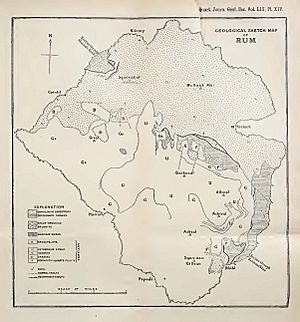Alfred Harker facts for kids
Alfred Harker (born February 19, 1859 – died July 28, 1939) was an English geologist. He was a very important scientist who studied rocks. He specialized in petrology, which is the study of how rocks form and change. He also used microscopes to understand rocks better.
For many years, he taught about rocks at the University of Cambridge. He also worked for the Geological Survey of Scotland. This meant he drew maps of rocks in western Scotland and the Isle of Skye. Alfred Harker and other geologists were among the first to use very thin slices of rock, called thin sections. They looked at these slices under a special petrographic microscope to learn more about rocks.
Contents
Becoming a Geologist
Alfred Harker was born in Hull, England. His father was a corn merchant. Alfred went to schools in Hull and Windsor. Later, he went to St. John's College at the University of Cambridge. He earned his Master's degree in 1882.
While at Cambridge, he joined the Sedgwick Club. This was a group for geology students. In 1884, he started teaching geology at Cambridge. His mentor was Professor Thomas McKenny Hughes. Alfred Harker became a lecturer at Newnham College in 1892. He then became a University Lecturer in 1904 and a Reader in Petrology in 1918.
Harker taught students about minerals and rocks. In 1885, he became a Fellow of St. John's College. In 1887, he traveled through Western Europe. He saw metamorphic rocks in the Ardennes region. This trip greatly influenced his research. In 1891, he went to the United States with Professor Hughes. They attended a big meeting for geologists.
Exploring Rocks and Lands
In 1895, Alfred Harker started working part-time for the Geological Survey of Great Britain. The head of the Survey, Archibald Geikie, invited him to help. Harker's job was to map and study the igneous rocks of the Isle of Skye and the Small Isles in Scotland. He worked on this until 1905. During this time, he also joined the Scottish Mountaineering Club.
Harker also worked with Professor John Edward Marr. They studied volcanic rocks in the Lake District in 1889. The Sedgwick Museum of Earth Sciences opened in 1904. Three years later, Harker published research on rock samples he had prepared. He even studied rock samples collected by Charles Darwin from his famous voyage on the HMS Beagle.
Alfred Harker collected 42,000 rock specimens himself. These form the main part of the Sedgwick Museum's rock collection. Today, this collection has over 150,000 rock samples and thin sections. It is known as the Harker Collection.
Later Life and Legacy
Alfred Harker retired in 1931. St. John's College made him a Life Fellow. This was a special honor. He passed away in 1939.
After he died, a book was published. It showed the geology and landscapes of the Western Isles of Scotland. Many of the pictures in the book came from drawings he made in his field notebooks.
Awards and Recognition
Alfred Harker received many honors for his work.
- In 1902, he became a Fellow of the Royal Society (FRS). This is a very high honor for scientists in the UK.
- He received the Royal Medal in 1935.
- The Geological Society of London gave him the Murchison Medal in 1907.
- He also received the Wollaston medal in 1922. He was even the president of this society from 1916 to 1918.
- The University of Edinburgh gave him an honorary law degree in 1919.
Places around the world are named after him:
- Harker Glacier on South Georgia Island
- Mount Harker in Antarctica
- Dorsa Harker, a feature on the Moon
- The mineral harkerite, found on the Isle of Skye, is also named after him.
After he retired, he became the honorary curator of the Cambridge Petrological Museum. The large rock collection there is named after him. Also, two lecture rooms at the Department of Earth Sciences, University of Cambridge are named in his honor.
His Papers and Records
Alfred Harker's papers are kept at the Sedgwick Museum of Earth Sciences in Cambridge. There are 13 boxes of his notes, sketchbooks, and photo albums. These show his geology trips in the UK from the late 1800s. They mostly cover the Isle of Skye, Isle of Arran, Yorkshire, and other parts of the Scottish Highlands. The collection also includes notes on specimens he collected, drafts of his lectures, maps, and some personal records.
Works
Here are some of the important books and papers Alfred Harker wrote:
- The Bala volcanic series of Caernarvonshire and associated rocks, 1889
- Petrology for Students, 1895
- The geology of North Arran, South Bute, and the Cumbraes, 1903
- The overthrust torridonian rocks of the Isle of Rum, 1903
- The Tertiary Igneous Rocks of Skye, 1904
- The Natural History of Igneous Rocks, 1909
- The Geology of the Small Isles of Inverness-shire, 1909
- Notes on geological map-reading, 1920
- Metamorphism: A Study Of The Transformations Of Rock-Masses, 1923, Second Edition 1939



